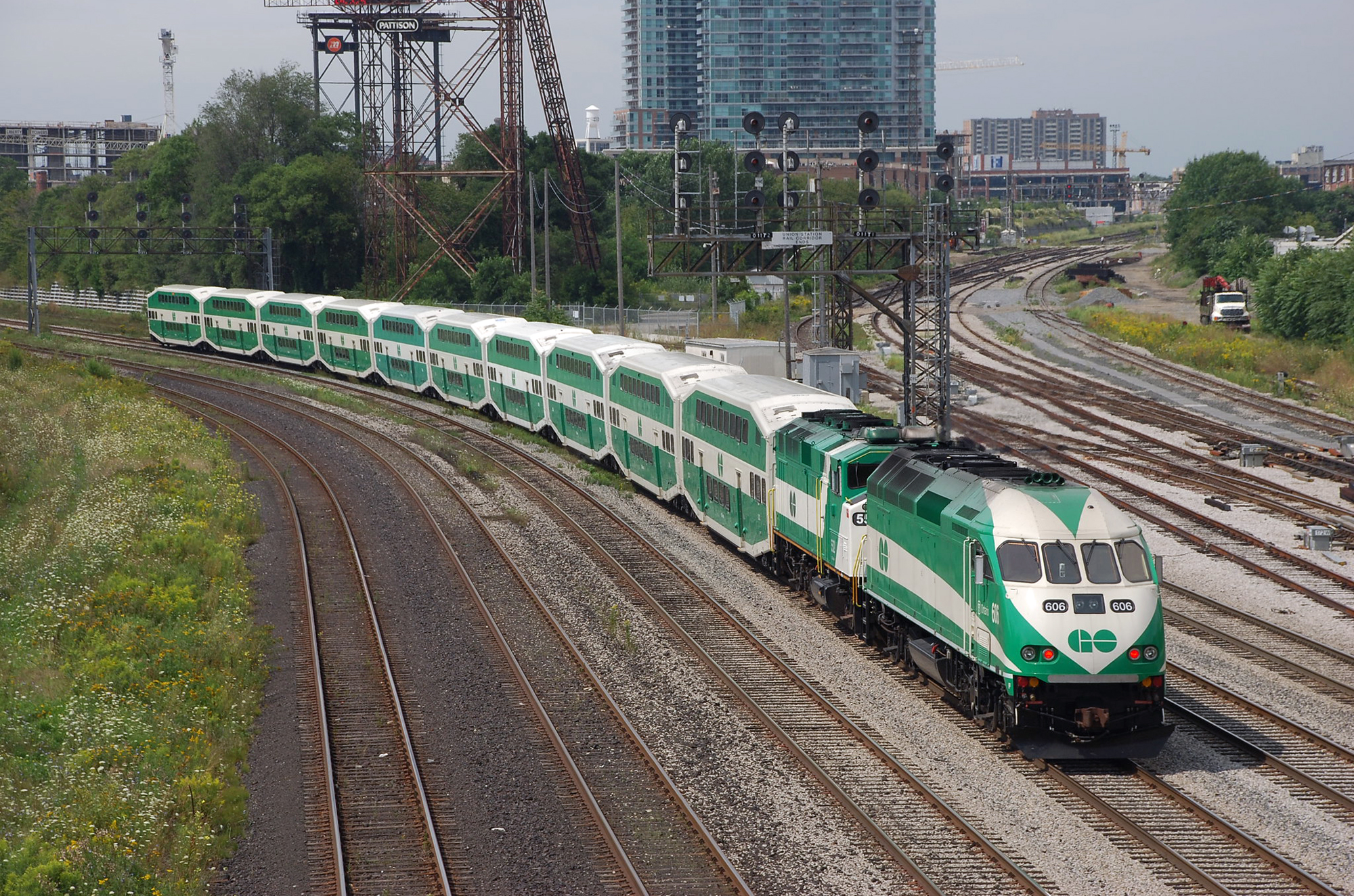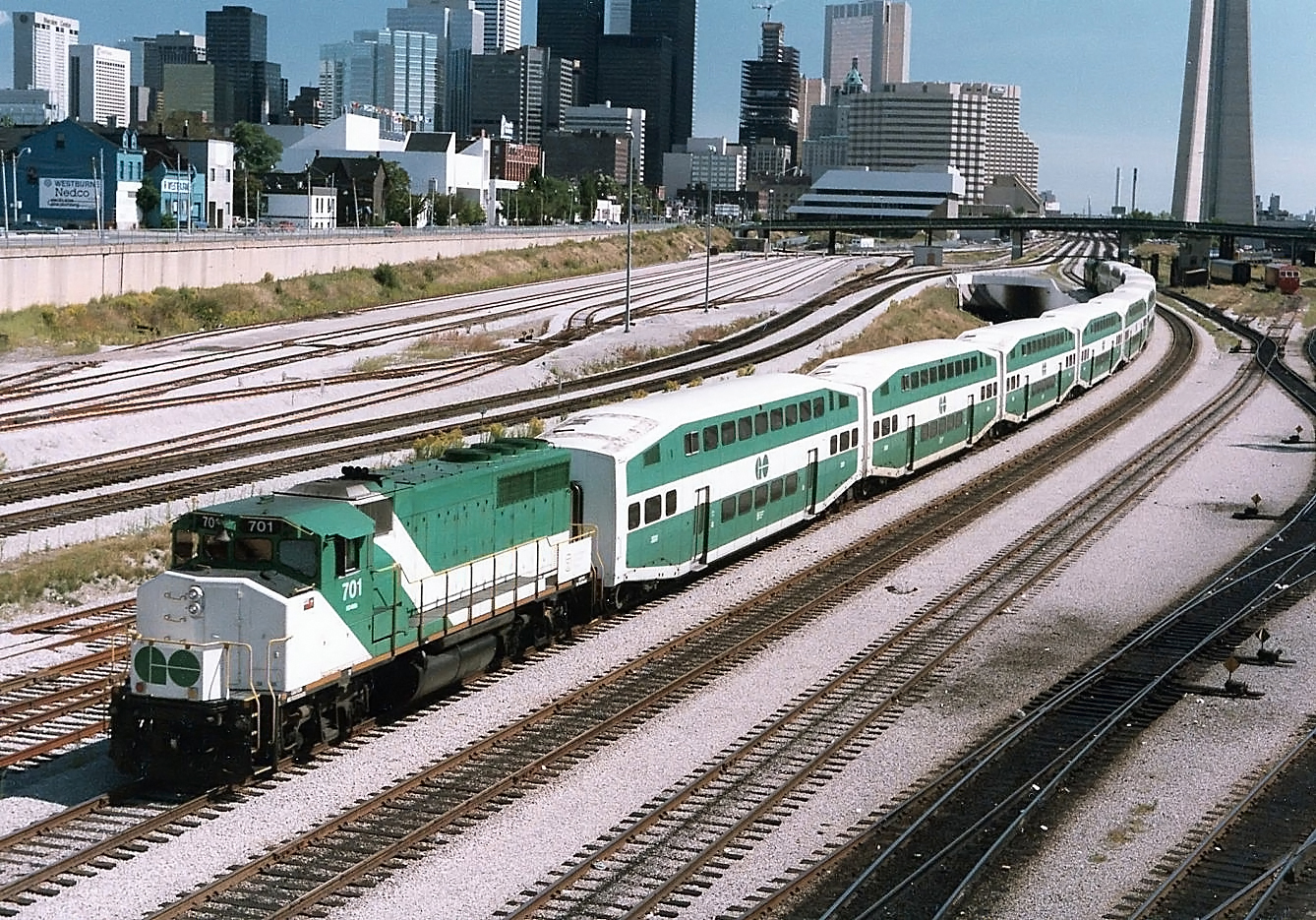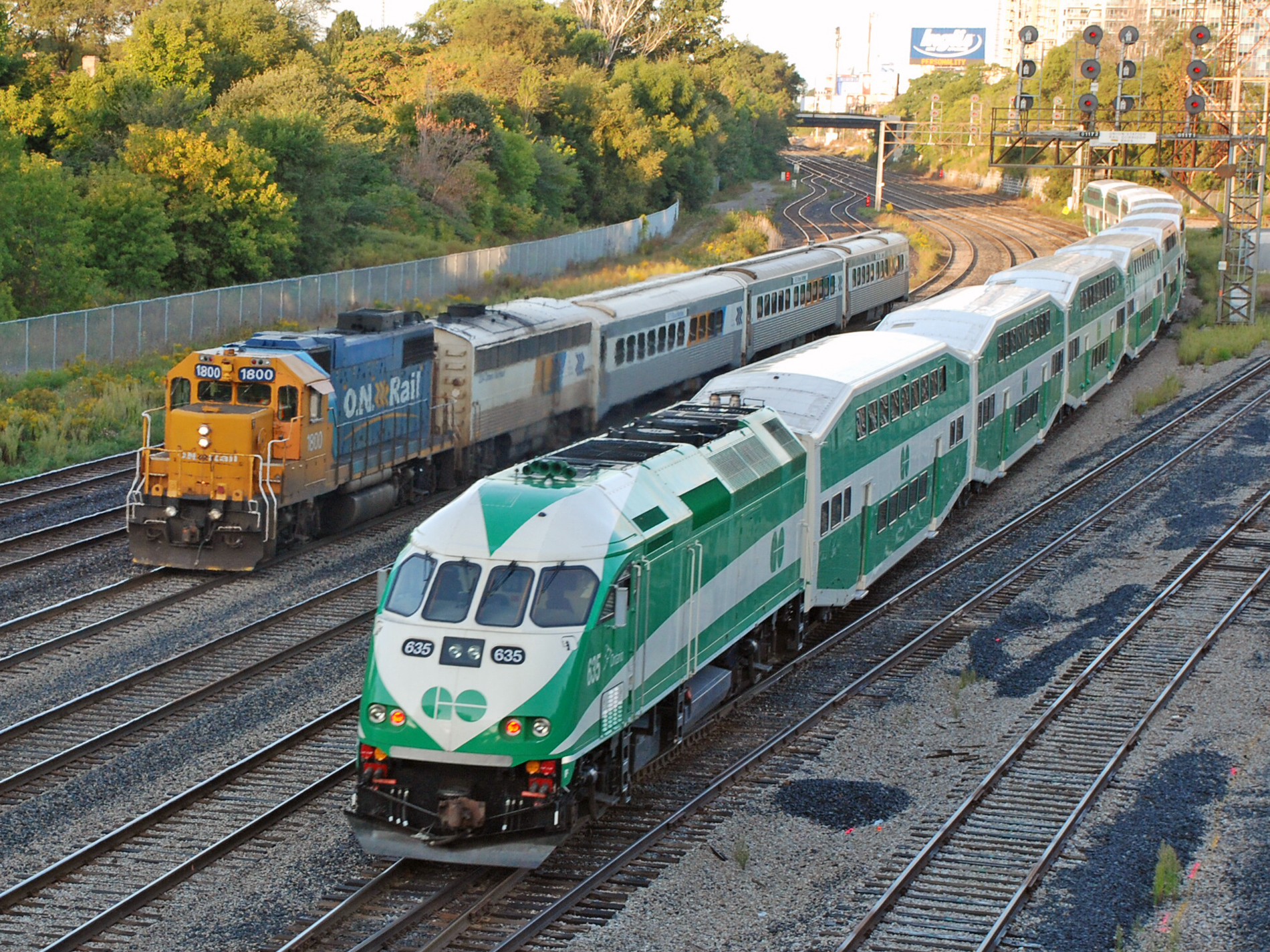GO Transit Commuter Rail: Serving Greater Toronto
Last revised: September 6, 2024
By: Adam Burns
GO Transit is a regional public transit system serving the Greater Toronto and Hamilton Area (GTHA) in Ontario, Canada.
Established in 1967, GO Transit has expanded significantly over the decades, evolving into one of North America's largest and most efficient commuter rail systems.
This guide provides a detailed overview of the GO Transit services, routes, facilities, and future developments to help commuters and visitors alike navigate this essential transportation network.
 GO Transit MP40PH-3 #606 and F59PH #552 handle train #911 at Bathurst Street in Toronto on August 22, 2009. Doug Kroll photo.
GO Transit MP40PH-3 #606 and F59PH #552 handle train #911 at Bathurst Street in Toronto on August 22, 2009. Doug Kroll photo.History and Background
Origins
GO Transit (shortened from Government of Ontario Transit), began as an experiment to alleviate burgeoning traffic congestion in Toronto. The first line, the Lakeshore line, began operations on May 23, 1967, running between Oakville and Pickering. Due to its immediate success, GO Transit became a permanent fixture in the Ontario transportation landscape.
Expansion
Over the years, GO Transit expanded its network, introducing new lines and services to meet the growing demand. Noteworthy expansions include:
- 1974: Georgetown Line (now Kitchener Line)
- 1978: Richmond Hill Line
- 1981: Milton Line
- 1982: Bradford Line
- 1982: Stouffville Line
These expansions have allowed GO Transit to serve a wider area, accommodating the rapid growth within the GTHA.
Service Overview
Routes and Lines
GO Transit operates seven commuter rail lines:
1. **Lakeshore West Line**
- Route: Toronto Union Station to Hamilton and Niagara Falls
- Key Stops: Oakville, Burlington, Aldershot, Hamilton
- Notable Service: Express services to reduce travel times
2. **Lakeshore East Line**
- Route: Toronto Union Station to Oshawa/Durham College
- Key Stops: Danforth, Pickering, Whitby, Ajax, Oshawa
- Notable Service: Frequent services, especially during rush hours
3. **Kitchener Line**
- Route: Toronto Union Station to Kitchener
- Key Stops: Bramalea, Georgetown, Guelph
- Notable Service: Planned expansions to Cambridge and beyond
4. **Milton Line**
- Route: Toronto Union Station to Milton
- Key Stops: Kipling, Cooksville, Streetsville
- Notable Service: High ridership during peak periods
5. **Richmond Hill Line**
- Route: Toronto Union Station to Richmond Hill and Bloomington
- Key Stops: Oriole, Langstaff
- Notable Service: Offers only peak-direction service during weekdays
6. **Stouffville Line**
- Route: Toronto Union Station to Old Elm
- Key Stops: Kennedy, Unionville, Mount Joy
- Notable Service: Weekend train services introduced in recent years
7. **Barrie Line**
- Route: Toronto Union Station to Barrie/Allandale Waterfront
- Key Stops: Downsview Park, Aurora, East Gwillimbury
- Notable Service: Seasonal service to cottage country
System Map
The GO Transit system map is divided into fare and service zones, depicting all routes, lines, and key interchanges with other public transport networks, including the Toronto Transit Commission (TTC), regional buses, and the forthcoming Ontario Line.
Operational Aspects
Frequency and Scheduling
GO Transit operates an extensive schedule, especially during peak commuter hours. Trains run with greater frequency during rush hours and less frequently during midday and late evening hours. Weekend and holiday services have also been enhanced to cater to the high demand for travel during leisure periods.
Ticketing and Fares
GO Transit uses a distance-based fare system, which is segmented into fare zones. Passengers can purchase tickets via several methods:
- **Presto Card:** A reloadable card providing fare discounts and ease of use across various transit systems in Ontario.
- **E-Tickets:** Available through the GO Transit mobile app.
- **Paper Tickets:** Available at stations and ticket vending machines.
Discounts are available for seniors, students, children, and frequent travelers.
 GO Transit GP40-2W #701 pulls a westbound commuter train out of Union Station in Toronto on September 1, 1984. Doug Kroll photo.
GO Transit GP40-2W #701 pulls a westbound commuter train out of Union Station in Toronto on September 1, 1984. Doug Kroll photo.Stations
GO Transit operates over 70 stations, each equipped with various amenities to enhance passenger experience. Stations typically feature:
- Parking facilities, including designated spots for electric and hybrid vehicles
- Bike racks and bike-sharing services
- Waiting areas with seating
- Customer service desks
- Vending machines and retail kiosks
- Wi-Fi access at certain locations
Onboard Services
Trains are designed to offer a comfortable and convenient travel experience. Onboard amenities include:
- Spacious seating with overhead storage
- Priority seating for passengers with disabilities or mobility issues
- Restrooms on longer routes
- Free Wi-Fi service on select trains
- Power outlets and USB charging ports
Park and Ride
GO Transit supports seamless multi-modal travel through extensive Park and Ride facilities. Many GO stations offer ample parking spaces where commuters can leave their cars and board the train. Various stations also provide connections to local bus services and shuttle options, ensuring last-mile connectivity.
Environmental Sustainability
GO Transit aims to minimize its environmental footprint through several initiatives:
- **Electrification:** Plans to electrify the rail network, starting with core segments such as the Lakeshore lines. Electrification reduces greenhouse gas emissions and operational costs.
- **Energy Efficiency:** Investment in energy-efficient locomotives and sustainable materials for station construction.
Future Developments
GO Transit continuously evolves to meet the demands of its growing ridership. Several major projects and initiatives are currently in the pipeline:
GO Expansion (RER)
The GO Expansion, previously known as Regional Express Rail (RER), is a comprehensive plan to modernize and expand the GO Transit network. Key components of the GO Expansion include:
- **Increased Service Frequency:** Moving towards two-way, all-day service, with trains running every 15 minutes on core segments.
- **Electrification:** Transitioning from diesel to electric trains, starting with the Lakeshore and Kitchener lines.
- **New Stations:** Construction of new stations to improve access and convenience.
- **Network Integration:** Enhancing connectivity with other transit systems, including the upcoming Ontario Line.
New Trains and Technology
GO Transit is investing in new train sets equipped with state-of-the-art technology to improve efficiency, comfort, and reliability. This includes:
- Electric Multiple Units (EMUs) for electrified lines
- Modern signaling and communication systems
- Real-time passenger information systems
Travel Tips and Best Practices
To make the most of the GO Transit services, consider the following travel tips and best practices:
Planning Your Journey
- Use the GO Transit website or mobile app for trip planning, timetables, and service updates.
- Pre-purchase tickets or load your Presto card in advance to avoid delays.
- Arrive at the station a few minutes before your train’s scheduled departure.
During Your Journey
- Keep your ticket or Presto card handy for inspection.
- Take advantage of the onboard amenities, such as free Wi-Fi and charging ports.
- Follow any onboard safety instructions and be mindful of priority seating.
Accessibility and Assistance
- If you require assistance, contact GO Transit’s accessibility services in advance to arrange for support.
- Make use of accessible entrances, elevators, and designated seating areas.
- Report any issues or concerns to onboard staff or station personnel.
Environmental Consciousness
- Whenever possible, use reusable containers and recycling options provided.
- Consider walking, biking, or using local transit to reach GO stations to reduce your carbon footprint.
- Support GO Transit’s environmental initiatives by participating in community programs and providing feedback.
 GO Transit MP40PH-3 #635 is pushing a westbound train at Bathurst Street in Toronto as it passes Ontario Northland GP38-2 #1800 on the Northlander, deadheading from the Willowbrook Yards to Union Station where it will pick up its passengers and begin its run north on September 16, 2012. Doug Kroll photo.
GO Transit MP40PH-3 #635 is pushing a westbound train at Bathurst Street in Toronto as it passes Ontario Northland GP38-2 #1800 on the Northlander, deadheading from the Willowbrook Yards to Union Station where it will pick up its passengers and begin its run north on September 16, 2012. Doug Kroll photo.Conclusion
GO Transit is an integral part of the Greater Toronto and Hamilton Area's transportation ecosystem, providing efficient, reliable, and sustainable commuter rail services. Through continuous expansion, modernization, and customer-focused initiatives, GO Transit is poised to meet the future mobility needs of the region.
Whether you are a daily commuter, a visitor, or a prospective rider, understanding the extensive offerings and capabilities of GO Transit enables you to make informed travel decisions, ensuring a smooth and enjoyable journey.
As GO Transit continues to evolve, it remains committed to enhancing connectivity, improving the passenger experience, and contributing to a more sustainable and vibrant region.
Recent Articles
-
Ohio - Whiskey - Train Rides
Dec 24, 25 05:47 PM
Ohio, with its rich history and scenic landscapes, offers an unusual yet delightful experience for spirit enthusiasts and travel aficionados alike: whiskey train rides. -
California Thomas The Train Rides
Dec 24, 25 05:44 PM
Held at various railroad museums and heritage railways across California, these events provide a unique opportunity for children and their families to engage with their favorite blue engine in real-li… -
Texas Thomas The Train Rides
Dec 24, 25 05:42 PM
In the heart of Texas, where everything is said to be bigger and bolder, lies an event that captures the imagination of children and families alike - A Day Out With Thomas.



